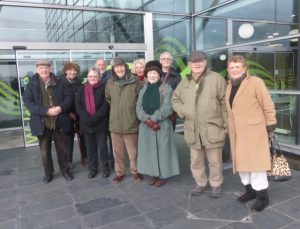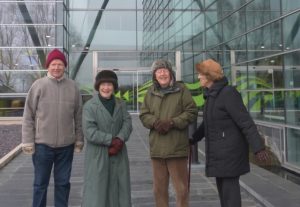Visit to the Met Office


On 11 February 2017 ten members met at the Met Office on a cold, damp day with a few flakes of snow for a visit arranged by Peter Wingfield-Digby. We got the usual jokes about seaweed and crystal balls over early and were met by Martin Young, a Deputy Chief, who then showed us what a large, scientific, complicated and international organisation the Met Office has become. The Office moved from Bracknell to the impressive modern building on A30 at Sowton in 2003. The changeover of operations took two very demanding days with both sites working in parallel to ensure continuity of output. Exeter is now the centre of operations with satellite offices in various parts of the UK and is responsible for all issued forecasts.
We were fortunate to be taken to the hub of the Office, the Central Forecasting Room, which is not usually shown to visiting groups. In the centre is the Central Forecast Guidance Unit, wherein sits the Chief Forecaster, which ensures consistency of output from all the individual forecasters and its interpretation by regional offices. Forecasts are primarily produced by computer modelling using a model devised by the Office but taking account of results from the models of other foreign offices. These models interpret a vast volume of data received from ground observation stations, buoys at sea and satellites. But the final result is modulated by a human forecaster using his or her expert knowledge. The Met Office produces worldwide forecasts and is one of two world area forecasting centres for aviation (the other being at Kansas in the USA). Around the Central Unit are specialist forecasting desks producing aviation, commercial, national and local forecasts. A recent speciality is flood forecasting in conjunction with the Environment Agency. Solar forecasting of flares is an important speciality.
We were allowed to peer through glass doors at one of the three supercomputers dispersed through the building and an adjacent site at the Science Park. These enormous machines, which together demand more electricity than the local suppliers can provide to a single site are among the most powerful in the World. Their computing method is based on dividing the surface of the Earth into areas of 17 Km side and calculating the values of parameters such as pressure, temperature and wind velocity at various altitudes at the corners of these areas. A finer resolution is used for UK forecasts.
Finally we were taken out to see the array of measuring instruments on trial for use by meteorologists worldwide. Some are little changed from the times when observations were made by humans but most are more sophisticated and are designed to operate automatically.
This was an informative and enjoyable visit. Thanks are due to the Met Office for allowing us to visit and especially to Martin Young who guided us in his own time.
George Garner
